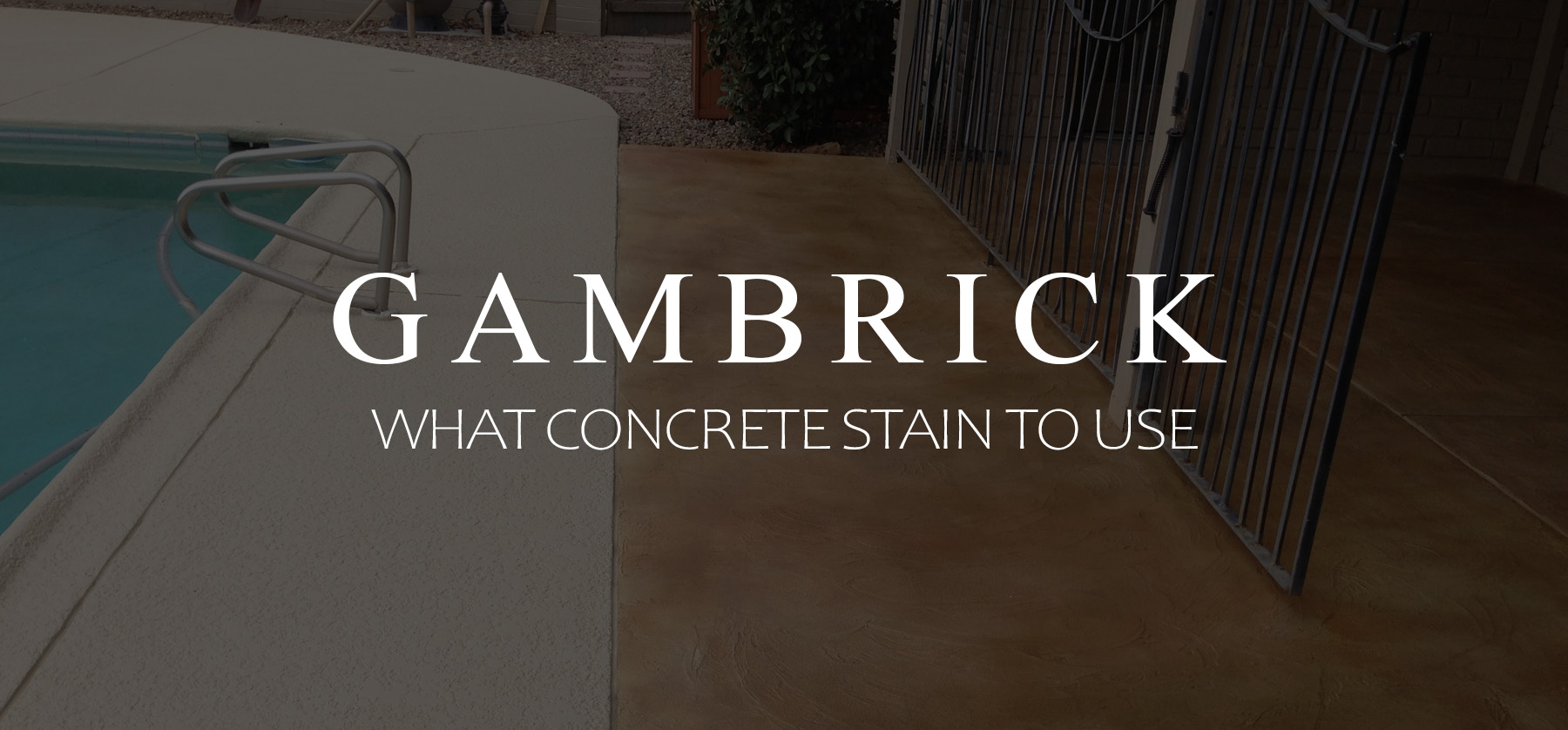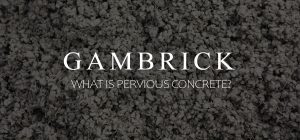
What Concrete Stain To Use
I’ve been a mason for over 25 years and can tell you firsthand what a fantastic building material concrete is, not only for it’s strength and versatility, but also its beauty. Concrete is used not only to build strong foundations and footings, but also as a finish material for walls, countertops, patios, statues, walkways, driveways, and sidewalks. But for some people, concrete’s grey color is a little boring, but that’s where stains can help. There are a variety of concrete stains on the market designed to fit a wide range of applications. Choosing which type of concrete stain is best for your particular project depends upon factors such as color and the location of your concrete.
There are two types of concrete stains, acid and water based. Acid stains give the concrete a more natural color and are more durable, making them better for outdoor use, while water based stains are bolder and look more like concrete paint, but they’re less durable, making them ideal for indoor use.
Where the concrete is located is also a huge factor. The best outdoor concrete stain isn’t necessarily the best for indoor use. And then there are environmental impacts to consider.
Whichever stain you choose, you need high quality rollers that are thick enough to penetrate into concrete’s deep pores. You’ll also need tough nylon brushes that won’t get chewed up by the concrete’s gritty texture.
Types of Stain
Concrete stains are different than paint.
Acid based stains have a translucent color that works with the natural color of the concrete instead of just covering it up. Because of concrete’s porous structure, stains penetrate into the concrete and react chemically, adding permanent color that won’t fade, chip, or peel. For years, acid stains have been used on concrete to achieve rich, earth toned colors that resembling natural stone.
But today, products such as water based stains are expanding the options with colors ranging from soft pastels to bold reds, oranges, yellows, greens and purples. Water based stains sit on top of the concrete’s surface acting more like a paint. They don’t react with the concrete color because their not absorbed. Because of this the colors can be bolder and more vibrant.
These days, with such a wider variety of concrete staining products, it’s possible to achieve almost any color scheme you want. Below we’ll look at the most popular concrete stains in more detail. Water and Acid based stains.
Acid Stains
Acid stains penetrate deep into the concrete’s pores and causes a chemical reaction between the muriatic acid and lime. This reaction leaves the concrete with a new permanently stained color. The stain contains a variety of minerals and acids which triggers a response that changes the color of your concrete. Because of how stain works, the finished color can vary depending on the concrete you use it one. For this reason it’s important to test the stain your using on the exact concrete your staining and not a test piece.
The biggest benefit of acid stains is that once they’re applied, the color is permanent and won’t fade, chip off, or peel. They’re also UV safe and fade resistant.
Acid stains usually come in natural earthy colors. The most popular acid stain colors are tan, brown, terracotta, and soft blue green. There are lots of variations within these overall colors so you’ll have plenty of options.
Generally acid stains are used if you want a subtle, more natural looking concrete. They’re more commonly used in the outdoors because acid stains are very durable and don’t need sealing. Acid stains are translucent and produce a unique look every time depending on the condition of the concrete and it’s original color.
Acid in the stain must be neutralized once it dries to stop the reaction with alkaline soap and water.
Water Based Stains
Water based concrete stains work a lot different then acid based stains. They contain particles too big to be absorbed by the concrete. Water based stains create a thin layer of color on the surface instead of penetrating and reacting with the concrete.
Water-based concrete stains are a newer, non-reactive way to stain concrete. Like acid stains, they are UV safe and can be used indoors and outdoors. But they offer a much larger choice of colors with longer working times. Although they’re not as durable as acid based stains. For this reason, water based concrete stains are generally used indoors.
Use water-based stains if:
- You want bolder more vibrant colors.
- You’d like to create artistic effects by blending or layering colors.
- You want a stain that’s safer and easier to apply.
Water-based stains have a more consistent color. They’re safer to apply, have faster drying times, are low in VOCs, and save time. Most water based stains call for acid washing prior to staining which prepares the concrete surface for better adhesion.
Because of how they work, water based stains are closer to paint than a stain. They’re more consistent and the color is easier to control. For this reason, water based stains come in colors that aren’t possible with acid based. A wider range of more vibrant colors are available. They come in yellow, orange, red and even have shades of black and white. They’re also much closer to the sample swab you buy at the store since they don’t react and change with the concrete on site.
If you use a water based stain on outdoor concrete, I recommend you seal it. The sealant will not only protect the concrete from water and weather related damage, but it will also protect the color.
Best Outdoor Concrete Stain
Typically, acid stains are a more durable choice for staining exterior concrete than water based formulas. Because they’re thinner and penetrate into the concrete, the color is permanent. Acid stains chemically react with the concrete and change it’s color, rather than just providing a coating. This means the color won’t chip or peel off and is fade resistant.
The down side to used acid stains are the color limitations. Acid stains aren’t as vibrant or bold. The coloring isn’t on the surface so it’s subtle and more natural.
These limitations can also be looked at as a good thing. Most people want a more natural looking color on their outdoor concrete. If what you want is a subtle tint then acid based concrete is the way to go.
Acid stains don’t need to be sealed which means no maintenance. This is a huge benefit to some homeowners. While a sealant will help protect your concrete and is a good idea to use, the coloring doesn’t need it.
I should not that water based stains also work really well outdoors as long as you seal them. They don;t have the same level of durability as acid stains so they need that extra layer of protection.
Best Interior Concrete Stain
Stains are a great way to finish an inside concrete slab. Both acid based and water based concrete stains can be used inside, but water based tends to work best in most situations. Since inside slabs don’t see the same wear and tear as outdoor concrete, you don’t need the extra durability acid stains provide.
Acid stains are more durable, but inside concrete doesn’t see the same type of wear and tear as outdoor concrete. Inside floors don;t get rained or snowed on, don’t deal with direct sunlight, and are generally temperature controlled which means no freeze/thaw cycles. Water based stains are also easier to apply, require less cleanup and aren’t as toxic.
Maintenance isn’t really an issue with indoor concrete. Since the wear and tear isn’t there, the stain won’t fade and the concrete doesn’t need to be sealed.
The thing you need to consider is color. If you want a more subtle, natural looking concrete, then choose an acid stain. However, if you want more vibrant color then choose something water based.
Choosing A Color
Choosing a color is the most important part of selecting the right type of concrete stain. The whole reason your staining is to change the concrete’s color so it makes sense to let that influence your stain type.
The first thing I would decide is if you want a bold color or something subtle and more natural. This one decision will dictate whether or not an acid or water based stain is the right choice for you. Because if you want a bold color, acid stains aren’t even an option.
- Acid Based. These stains are more subtle. They tend to be earthy and more natural looking. I think of acid based stains as more of a tint. When you acid stain concrete some of the original colors show through.
- Water Based. These stains are bolder and act more like a paint. They sit on top of the surface and don’t interact as much with the concrete’s color. For this reason you can achieve much bolder,more vibrant color.
Stains can be mixed together to create a custom color just like paint. This is true of both acid and water based stains. However it’s a little easier with water based because the colors are more pronounced and don’t interact with the concrete as much. Stains need concrete to achieve their final color so they’re harder to customize how you want them. But it’s still possible with both stain types. Experiment with colors to achieve the look you want. Find a base and then add a little second color to tint it exactly how you want it.
Testing Color
Choosing the right concrete stain to use has a lot to do with color. Always test a color before applying it to concrete. Stains are permanent. Don’t rush and stain an entire floor only to realize later that you don’t like the color. It’s not like painting a wall where you can just go over it again if you don’t like the color. This is especially true with acid stains. They penetrate so deep into the concrete pores that you can’t remove them.
Find small out of the way area and apply a little stain. If your staining inside concrete then a little spot in a closet somewhere is a great place to test a color. If outside, find a little spot that’s on an edge and out of the way. Just a small spot the size of a nickel is more than enough.
Testing stain colors is even more important when your mixing a custom color. With more popular basic colors the result will be more consistent. The base colors are factory made and generally look very close, and often exactly like, the sample. But when you make a custom color there’s no way to know what it’ll look like without testing it out first.
In general, if you want to choose the best concrete stain, take your time and do a little color testing first.
Concrete Stains Are Permanent
When choosing the best concrete stain to use you should also consider it’s durability and where you’ll be using it.
Concrete acid stains sink into the concrete’s pores which makes them nearly impossible to get out. If you want to change the color of an acid stained slab then you only have one real choice, cover it up.
Covering concrete that’s been acid stained isn’t easy. If you use more acid stain then the new color will interact with the old. Usually this produces an unattractive muddy look. Water based stains can be layered on top of the old stain but they’re semi solid so some of the original color will again come through. This can also produce a muddy look. Solid concrete paints can be used which completely covers the old stains but they don’t look at all natural. It’s best to get it right the first time.
A tough, durable concrete stain can be a great thing too. The wear and tear that can deteriorate surface colors don’t have as much effect on acid stains because they’ve permanently penetrated into the concrete. If you want durability then go with an acid stain. Water stains are pretty durable too but they need a sealer to help protect them. While water based stains aren’t as durable as acids, they typically hold up better than paint.
How To Stain Concrete
Staining concrete is pretty simple process. The steps are pretty much the same no matter which type of stain you use. Here are the basic steps you need to take.
1. Clean & Dry The Surface
Make sure the concrete is free of any debris, oil, dirt, sealers, other stains, paint, pollen, and dust. The stain can’t penetrate into the concrete if there are other substances in it’s way. Use a pressure washer, broom, vacuum, or scrub brush. Scrape off any gunk or glue that’s on the concrete. What you want is clean, bare concrete.
2. Prep The Concrete
Before you start staining you should tape off any areas you don’t want stained.
3. Apply The Stain
Use the proper safety equipment like a face mask, gloves, and goggles. Proper ventilation is also important. Use a paint sprayer, a roller or both. Make sure to get even coverage. Roll or spray on thin coats. I like to spray on my first thin coat and then roll on a second and sometimes even a third. This gives me much better coverage.
4. Neutralize The Stain
If you used an acid stain then you need to neutralize it. Once the concrete has achieved the desired color, grab a mop and scrub brush to get off the excess acid. Mop over it with a solution of ammonia and water. Rinse it off until the water coming off the concrete is clean. Then let it dry.
5. Seal The Concrete
You don’t have to seal your concrete but it’s recommended. Sealing is more important with water based stains then with acids because they’re not as durable. The sealer sits on top of the stain which helps protect it. You can also get a sealer with a gloss that gives a floor a wet look. Apply the sealer with a roller or sprayer just like you did the stain. Thin even coats work best. Le tit dry when complete.
Re-staining Concrete
Concrete stains are permanent so make sure you choose a color that you really like. But in some cases you may eventually want to re-stain. How you go about doing it depends on the original type of stain that was used.
Re-staining Acid Stains
It’s hard to re-stain concrete, especially if your first coat was an acid stain. Acid stains get inside the concrete’s pores and actually chemically react with the concrete changing it’s color. They can’t be removed so all you can do is cover them up.
If your second coat is also an acid stain then it will have to work with the existing base color. Acid stains are thin and act more like a tint rather than a paint. A lot of testing will have to be done. Generally I don’t recommend using an acid stain over an older acid stain. It’s so hard to get the final color to look good unless the original color was very light. The result is usually just a dark muddy color.
Water based stains are a better option over an old acid stain. These types of stains sit on top of the concrete and act more like a paint. Because of how they work the colors are bolder and aren’t as effected as the under color.
Re-staining Water Based Stains
An old water based stain can be partially removed. They’re a surface layer stain which doesn’t penetrate deep into the concrete’s pores which means you can usually get them off. Unless your concrete is very porous. The denser the concrete the easier it is to remove old water stains.
Once the old stain is removed, go over it with a new water based stain. You can use an acid stain if all the old stain was removed but that’s hard to do. Usually some of the old stain stays behind.
How Much Concrete Stain Do I Need?
To determine how much stain you need for your project you will need to know the following:
- The coverage rate of the stain you plan to use
- How many square feet of concrete you will be staining
- How many coats of stain you will be applying
- The condition of your concrete
Coverage rates are usually listed on the bottle in square feet per gallon. The age and condition of the concrete will impact the coverage rate. More porous concrete needs more stain because it absorbs into the pores. Newer, denser concrete has less pores so it requires less stain.
Cracks can also be an issue. They suck up and waste stain. Make sure to seal them all prior to staining.
On average, acid stains will cover 200 to 400 square feet per gallon, while water based stains will cover slightly more at about 250 to 450 square feet per gallon. Both acid based and water based stains can be diluted to get more coverage, however this will also lessen the intensity of the color.
If you plan on applying more than one coat of stain, keep in mind that 2nd and 3rd coats usually require less product than the first coat.
How Does Does Concrete Stain Take To Dry?
Acid stain will be dry to the touch in around 20 minutes, but that doesn’t mean the chemical reaction is complete. If your applying multiple coats of stain, allow about an hour of dry time in between. If you want to speed this up then use a fan. Air flow helps the concrete stain dry out.
Most stain manufacturers recommend a total dry time of up to 24 hours after all coats have been applied.
Drying times for concrete stains will vary based on:
- Concrete Condition
- Air and Surface Temperature
- Humidity
- Concrete Porosity
After the stain has dried, the acid needs to be rinsed and neutralized.Use an alkaline soap and water to do it. Rinse the surface until the water runs clear.
Wait another few hours for the concrete to dry before applying a sealer. The concrete must be completely dry and free of residue for the sealer to bond.
Overall, the staining and sealing process takes 2 to 3 days.
Water based stains dry faster than acid stains and don’t require neutralization before sealing. This makes them a much better choice if your in a hurry.
Tips
Choosing which concrete stain to use is a very important part of many concrete projects. The type of stain you use and the color will have an effect on your concrete for years. It’s a decision you should consider carefully. Here’s a few more tips to help.
- Make sure that the concrete is fully cured before you begin applying stains. This normally takes 28 days from the time the concrete was poured.
- Sealing the concrete after it’s been stained is recommended. Especially if your using water based stains outdoors. Acid stains are more durable so it isn’t as important.
- Water and acid based stains can be used together to achieve some really cool colors and effects. Just make sure to apply the acid stain first.
- On average, acid stains will cover 200 to 400 square feet per gallon, while water-based stains will cover around 250 to 450 square feet per gallon. This is because acid stains penetrate into the concrete and water stains don’t.
- The more porous your concrete is the more stain it’ll take to cover it. Old concrete can soak up 40% more stain than new concrete because of it’s larger pores and cracks.
- Seal any cracks before you start staining.
- Allow an hour or so between coats if you’re doing multiple coats.
- Don’t rush a concrete stain job. Let the coats dry before applying another coat. If your in a rush use a fan to dry out the stain faster.
Summary: What Concrete Stain To Use
I’ve been a mason for over 25 years and can tell you firsthand what a fantastic building material concrete is, not only for it’s strength and versatility, but also its beauty. Concrete is used not only to build strong foundations and footings, but also as a finish material for walls, countertops, patios, statues, walkways, driveways, and sidewalks. But for some people, concrete’s grey color is a little boring, but that’s where stains can help. There are a variety of concrete stains on the market designed to fit a wide range of applications. Choosing which type of concrete stain is best for your particular project depends upon factors such as color and the location of your concrete.
There are two types of concrete stains, acid and water based. Acid stains give the concrete a more natural color and are more durable, making them better for outdoor use, while water based stains are bolder and look more like concrete paint, but they’re less durable, making them ideal for indoor use.
Where the concrete is located is also a huge factor. The best outdoor concrete stain isn’t necessarily the best for indoor use. And then there are environmental impacts to consider.
Whichever stain you choose, you need high quality rollers that are thick enough to penetrate into concrete’s deep pores. You’ll also need tough nylon brushes that won’t get chewed up by the concrete’s gritty texture.
If you have any questions or comments email us any time.

John Mazzuca | About | More Posts |
Custom Home Builder
John Mazzuca is a custom home designer and builder at Gambrick with over 25 years experience in the construction industry. John has designed, built and/or remodeled hundreds of homes, small buildings, and commercial projects. He writes about business, real estate, home building, and household electronics. His work has been featured in Fox Business, Better Homes & Garden, House Beautiful, and more.




















